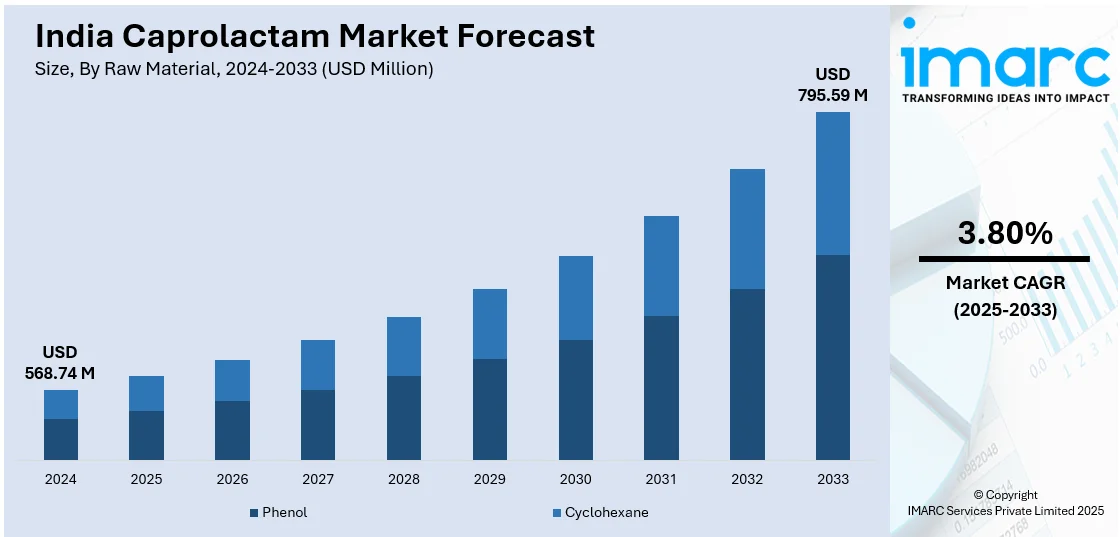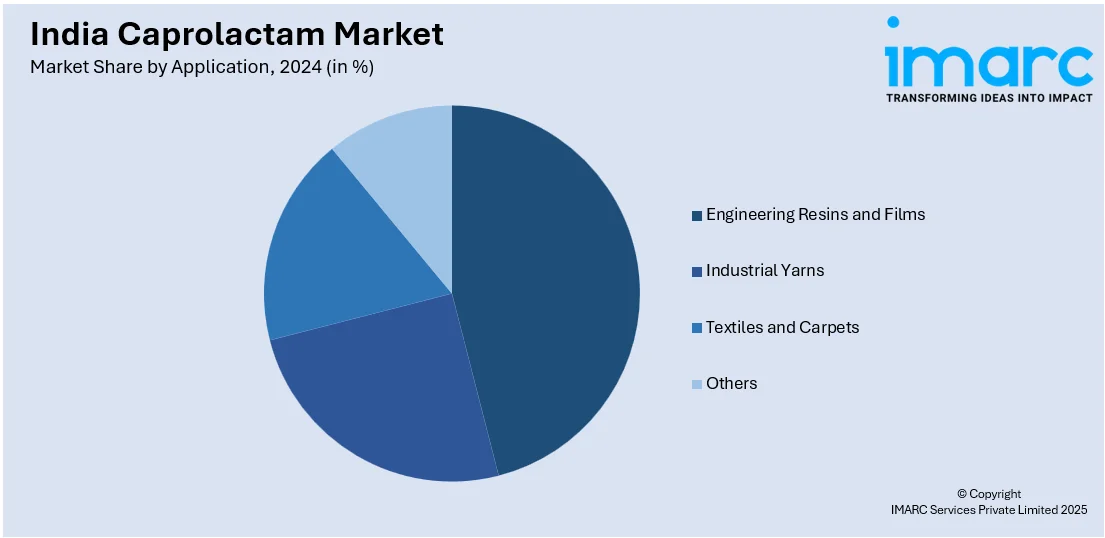
India Caprolactam Market Size, Share, Trends and Forecast by Raw Material, Application, End Product, and Region, 2025-2033
India Caprolactam Market Overview:
The India caprolactam market size reached USD 568.74 Million in 2024. Looking forward, IMARC Group expects the market to reach USD 795.59 Million by 2033, exhibiting a growth rate (CAGR) of 3.80% during 2025-2033. The rising demand for nylon 6 in automotive, textile, and industrial applications, increasing urbanization and infrastructure development, supportive government policies, growing investments in the chemical sector, continual technological advancements in production processes, and a robust manufacturing base catering to domestic and export demands are some of the major factors augmenting the India caprolactam market share.
|
Report Attribute
|
Key Statistics
|
|---|---|
|
Base Year
|
2024 |
|
Forecast Years
|
2025-2033
|
|
Historical Years
|
2019-2024
|
| Market Size in 2024 | USD 568.74 Million |
| Market Forecast in 2033 | USD 795.59 Million |
| Market Growth Rate 2025-2033 | 3.80% |
India Caprolactam Market Trends:
Growing Demand from the Automotive Sector
The thriving automotive industry in India is a significant contributor to the India caprolactam market growth. According to an industry report, vehicle production in India grew from 2 Million units in 1991-92 to 28 Million units in 2023-24, reflecting the country's rapidly expanding automotive sector. This significant rise in production has led to a growing demand for advanced materials like Nylon 6, which is derived from caprolactam. Nylon 6 is widely used in the automotive sector for manufacturing lightweight and durable components. As vehicle manufacturers prioritize fuel efficiency and lower emissions, the demand for lightweight materials like Nylon 6 is on the rise. It is commonly used in automotive parts such as radiator grilles, engine covers, air intake manifolds, and fuel system components. Additionally, the rise in electric vehicle (EV) production is further accelerating the adoption of high-performance plastics. Caprolactam's properties, including resistance to chemicals, heat, and abrasion, make it a preferred choice for automotive applications. Moreover, the implementation of government initiatives promoting local vehicle production under schemes like "Make in India" and the implementation of stricter emission standards are also fostering the growth of caprolactam in automotive manufacturing. The growing consumer preference for personal mobility, alongside increased investments in the automobile sector, is expected to sustain the demand for Caprolactam in this segment.

To get more information on this market, Request Sample
Expansion of the Textile Industry
India's thriving textile industry is significantly contributing to the demand for caprolactam. Nylon 6 is extensively used in the production of synthetic fibers for textiles, including apparel, sportswear, and industrial fabrics. The textile sector benefits from caprolactam's strength, elasticity, and resistance to wear, making it suitable for high-performance and functional fabrics. According to an industry report, India's textile market is expected to reach USD 213.5 Billion by 2033, exhibiting a growth rate (CAGR) of 3.85% during 2025-2033. This anticipated growth presents significant opportunities for the caprolactam market, as Nylon 6 remains a key material in textile manufacturing. Additionally, the booming e-commerce sector is enhancing access to a diverse range of clothing options, further accelerating the consumption of synthetic fibers. The rising popularity of athleisure and activewear, which require robust and flexible materials, further increases the usage of Nylon 6 in fabric production. Also, government incentives, export-driven production, and investments in textile parks are positively impacting the India caprolactam market outlook. Furthermore, advancements in dyeing and finishing technologies have expanded Nylon 6 applications in premium and sustainable textile products, contributing to its sustained demand.
India Caprolactam Market Segmentation:
IMARC Group provides an analysis of the key trends in each segment of the market, along with forecasts at the country level for 2025-2033. Our report has categorized the market based on raw material, application, and end product.
Raw Material Insights:
- Phenol
- Cyclohexane
The report has provided a detailed breakup and analysis of the market based on the raw material. This includes phenol and cyclohexane.
Application Insights:

- Engineering Resins and Films
- Industrial Yarns
- Textiles and Carpets
- Others
A detailed breakup and analysis of the market based on the application have also been provided in the report. This includes engineering resins and films, industrial yarns, textiles and carpets, and others.
End Product Insights:
- Nylon-6 Fibers
- Nylon-6 Resins
- Others
The report has provided a detailed breakup and analysis of the market based on the end product. This includes nylon-6 fibers, nylon-6 resins, and others.
Regional Insights:
- North India
- South India
- East India
- West India
The report has also provided a comprehensive analysis of all the major regional markets, which include North India, South India, East India, and West India.
Competitive Landscape:
The market research report has also provided a comprehensive analysis of the competitive landscape. Competitive analysis such as market structure, key player positioning, top winning strategies, competitive dashboard, and company evaluation quadrant has been covered in the report. Also, detailed profiles of all major companies have been provided.
India Caprolactam Market Report Coverage:
| Report Features | Details |
|---|---|
| Base Year of the Analysis | 2024 |
| Historical Period | 2019-2024 |
| Forecast Period | 2025-2033 |
| Units | Million USD |
| Scope of the Report |
Exploration of Historical Trends and Market Outlook, Industry Catalysts and Challenges, Segment-Wise Historical and Future Market Assessment:
|
| Raw Materials Covered | Phenol, Cyclohexane |
| Applications Covered | Engineering Resins and Films, Industrial Yarns, Textiles and Carpets, Others |
| End Products Covered | Nylon-6 Fibers, Nylon-6 Resins, Others |
| Regions Covered | North India, South India, East India, West India |
| Customization Scope | 10% Free Customization |
| Post-Sale Analyst Support | 10-12 Weeks |
| Delivery Format | PDF and Excel through Email (We can also provide the editable version of the report in PPT/Word format on special request) |
Key Benefits for Stakeholders:
- IMARC’s industry report offers a comprehensive quantitative analysis of various market segments, historical and current market trends, market forecasts, and dynamics of the India caprolactam market from 2019-2033.
- The research report provides the latest information on the market drivers, challenges, and opportunities in the India caprolactam market.
- Porter's five forces analysis assist stakeholders in assessing the impact of new entrants, competitive rivalry, supplier power, buyer power, and the threat of substitution. It helps stakeholders to analyze the level of competition within the India caprolactam industry and its attractiveness.
- Competitive landscape allows stakeholders to understand their competitive environment and provides an insight into the current positions of key players in the market.
Key Questions Answered in This Report
The caprolactam market in India was valued at USD 568.74 Million in 2024.
The India caprolactam market is projected to exhibit a CAGR of 3.80% during 2025-2033, reaching a value of USD 795.59 Million by 2033.
The rapid expansion of the automotive sector in India is increasing the use of nylon-based parts for weight reduction and fuel efficiency. Additionally, rising need for synthetic fibers in garments and industrial fabrics is supporting the market growth. Domestic production capacity expansion and the growing investments in downstream processing industries are also offering a favorable market outlook.
Need more help?
- Speak to our experienced analysts for insights on the current market scenarios.
- Include additional segments and countries to customize the report as per your requirement.
- Gain an unparalleled competitive advantage in your domain by understanding how to utilize the report and positively impacting your operations and revenue.
- For further assistance, please connect with our analysts.
 Request Customization
Request Customization
 Speak to an Analyst
Speak to an Analyst
 Request Brochure
Request Brochure
 Inquire Before Buying
Inquire Before Buying




.webp)




.webp)












